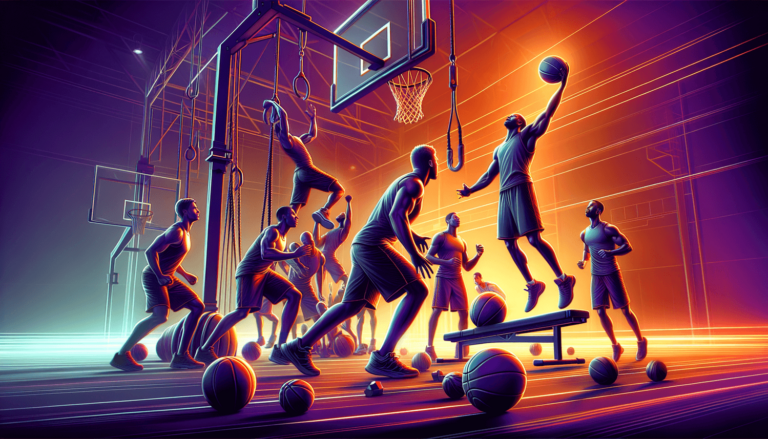
What’s a Basketball Strength and Conditioning Program?
Written by: Basketball Universe
Last updated:

Welcome to the exciting world of basketball strength and conditioning! 🏀 Whether you’re a budding athlete looking to up your game or a curious fan wanting to gain some behind-the-scenes knowledge, a well-designed strength and conditioning program is integral to any basketball player’s success. In this informative blog post, we will delve deep into the essence of these programs, the rationale behind them, and the various components that work in unison to help athletes achieve peak performance. So, lace up your sneakers, grab your sweatbands, and let’s get ready to explore the dynamic world of basketball training!
What’s a Basketball Strength and Conditioning Program?
A basketball strength and conditioning program is a strategic and systematic training plan designed to improve a player’s physical abilities, such as strength, power, agility, endurance, and flexibility. These programs are individualized to suit each athlete’s unique needs and goals, while also addressing injury prevention and recovery. By integrating sport-specific exercises and conditioning drills, the program aims to optimize on-court performance and prepare athletes for the demanding nature of basketball.
The Building Blocks of a Basketball Strength and Conditioning Program
Understanding the fundamental elements of a comprehensive basketball strength and conditioning program can significantly benefit athletes of all levels. Carefully crafted workouts address specific components, such as strength training, power and explosiveness, endurance, speed, and agility. Let’s examine each of these components in greater detail and explore their impact on on-court performance.
Strength Training
Strength training in basketball serves as the foundation for dynamic performance on the court, with its primary focus on building overall muscular strength. Developing stronger muscles helps players withstand the physical demands of the sport and prevents injuries. Moreover, strength training aids in improving rebounding, shot power, and overall stability while executing essential basketball moves.
Popular exercises in strength training programs for basketball include squats, deadlifts, and bench presses, yielding both functional and sport-specific benefits. A well-rounded training routine should also incorporate crucial upper and lower body exercises to ensure overall muscular balance and to reduce injury risk.
Power and Explosiveness
Next to strength, power and explosiveness are two of the most critical aspects of a basketball player’s arsenal. By enhancing power, athletes can improve their vertical jump height and speed on the court, thus refining their overall performance. Training for explosiveness typically involves plyometric exercises, which are quick, forceful movements that help develop speed and power in the muscles.
Examples of plyometric exercises commonly found in basketball strength and conditioning programs include box jumps, squat jumps, and medicine ball throws. Incorporating these exercises regularly will significantly impact an athlete’s ability to swiftly change direction, effectively dunk, and block shots.
Endurance
As a fast-paced and physically demanding sport, basketball requires high levels of endurance. Continuous movement and high-intensity actions throughout a game can quickly fatigue the muscles, thus impacting overall performance. Endurance training specifically targets a player’s aerobic and anaerobic capacities to maintain peak performance levels throughout extended gameplay.
Cardiovascular exercises such as running, cycling, and skipping can vastly benefit basketball players by improving muscle endurance, stamina, and resilience against fatigue. Moreover, performing interval training and high-intensity interval training (HIIT) can also develop the necessary endurance for fast breaks and intense defensive stances on the court.
Speed and Agility
Speed and agility are essential skills for basketball players, enabling them to respond quickly to changes in gameplay and execute rapid transitions. Agility training focuses on enhancing the ability to change direction and accelerate quickly, crucial for players looking to evade the opposition and create scoring opportunities.
Drills like ladder exercises, cone drills, and shuttle runs aid in developing speed and agility, complimenting other components of a basketball strength and conditioning program. Combined, these drills help players swiftly weave through the defense and maintain a fast tempo during games.
Periodization: Structuring Your Basketball Training
Periodization entails organizing and planning appropriate training phases to maximize a player’s long-term development and performance. The model of periodization often includes three components: macrocycles, mesocycles, and microcycles.
Macrocycles
A macrocycle refers to a long-term, overarching training plan extending from 12 to 52 weeks. It is typically structured around seasonal competitions, with strength and conditioning coaches adjusting both volume and intensity to optimize performance peaks during the season.
Mesocycles
Mesocycles are shorter, more focused training periods usually lasting four to 12 weeks, divided into different phases such as preparatory, competitive, and transition. Each phase will target different aspects of strength and conditioning, adapting to the player’s specific needs based on their progress and the stage of the basketball season.
Microcycles
Microcycles are the shortest of the training cycles, lasting one to four weeks, and are tailored to address specific objectives within a mesocycle. Microcycles involve a detailed, week-by-week program that takes into account the athlete’s workload, recovery, and periodization goals within the larger training timeline.
Implementing a Basketball Strength and Conditioning Program: Tips and Suggestions
Now that we’ve explored the fundamental components of a basketball strength and conditioning program and described the periodization model, here are some practical tips and suggestions for athletes looking to develop and enhance their on-court performance.
Set Realistic Goals
Before embarking on a basketball-centric training program, it’s essential to set realistic and attainable goals for yourself. This process will help maintain motivation and commitment while allowing you to measure progression and adapt your workouts as needed.
Work Closely With a Strength and Conditioning Coach
Working with a certified strength and conditioning coach is an excellent way to ensure your training program is tailored to your individual needs and goals. These professionals possess specialized knowledge and experience, facilitating the development of safe and efficacious training routines that yield optimal results.
Maintain Proper Nutrition and Hydration
Proper nutrition and hydration play a significant role in an athlete’s performance and recovery. Maintaining a balanced diet, high in protein and essential nutrients, and ensuring adequate hydration throughout the day are crucial for supporting the training demands of a basketball strength and conditioning program.
Value Rest and Recovery Days
Rest and recovery are often overlooked aspects of an effective training program. Ensure to include active recovery days to help your muscles restore and rejuvenate. Additionally, a well-balanced program should include flexibility and mobility exercises such as yoga or foam rolling to promote muscle health and prevent injury.
Track Your Progress
Tracking and evaluating your progress throughout the program will help to measure success and identify areas that need further improvement. Regular assessments can provide insight into the effectiveness of your current training routine and allow necessary adjustments to maintain a path towards your goals.
Dynamic Warm-ups and Preventing Injuries in Basketball
Prioritizing injury prevention is essential in basketball strength and conditioning programs. A crucial aspect of preventing injuries is incorporating dynamic warm-ups and stretching exercises into your routine. These exercises help prepare the body for training and should be performed before each workout to maintain flexibility, minimize muscle imbalances, and lower the risk of injury.
Dynamic Warm-ups
Dynamic warm-ups involve full-body movements that activate critical muscle groups utilized during basketball-specific exercises. Examples of dynamic warm-up exercises include high knees, butt kicks, and spiderman lunges. Incorporating these movements helps amplify joint mobility, increase blood flow, and enhance muscle elasticity, ultimately preparing the body for high-intensity workouts.
Stretching
Stretching exercises play a vital role in preserving and improving overall flexibility, a key factor in reducing injury risk. Engaging in regular static and dynamic stretching not only promotes a healthy range of motion but can also relieve muscular tension and prevent soreness. Devote time both before and after workouts for stretching to ensure your muscles and joints can handle the intense physical demands characteristic of basketball.
Conclusion
In summary, an effective basketball strength and conditioning program combines several vital components, such as strength training, power, endurance, speed, and agility. Following a periodization model and implementing practical tips and suggestions can help athletes at all levels enhance their overall performance, prevent injury, and take their basketball skills to new heights. Through dedication, consistency, and a well-crafted program, you’ll find yourself soaring down the court and dominating the competition in no time! 🏀
Core Training and Stability
In addition to the main components discussed earlier, core training and stability play a significant role in a basketball strength and conditioning program. A strong and stable core is crucial for maintaining balance, generating power, and facilitating efficient movement patterns during basketball gameplay.
Core exercises, such as planks, Russian twists, and leg raises, help improve balance and stability by reinforcing abdominal, lower back, and hip muscles. By incorporating core exercises into your training routine, you’ll gain an edge in on-court performance by displaying more control over your body movements when executing complex basketball techniques.
Mental Conditioning and Readiness
Often overlooked, mental conditioning and readiness are integral elements of a comprehensive basketball strength and conditioning program. Basketball is not only physically demanding but mentally challenging as well. Players must maintain focus, composure, and resilience under pressure to excel on the court. Mental conditioning exercises, such as visualization, positive self-talk, and mindfulness practices, can significantly boost a player’s mental fortitude and enhance overall performance.
To develop mental readiness and perform optimally during high-pressure situations, consider incorporating various mental conditioning techniques into your strength and conditioning program. These exercises will help you remain composed and make strategic decisions, ultimately contributing to both individual and team success.
Supplemental Activities for Improved Performance
Basketball players can benefit from engaging in supplemental activities to further enhance their strength and conditioning program. These activities may include:
Cross-Training
Cross-training is the practice of engaging in various types of exercises or sports to improve overall fitness and prevent burnout from focusing solely on basketball training. Examples of cross-training activities include swimming, cycling, and yoga, all of which can contribute to injury prevention and improved performance in basketball by diversifying your overall training approach.
Footwork Drills
Footwork drills are an essential part of any basketball player’s training routine, as sharp footwork enables better control on the court. Incorporate exercises like defensive slides, line jumps, and agility ladder drills to hone your footwork skills, improve quickness, and stay ahead of your competition.
Position-Specific Training
Position-specific training tailors a strength and conditioning program to the unique needs and demands of each basketball position (guard, forward, or center). By focusing on the specific attributes required for your position, you can optimize your performance and bring invaluable contributions to your team. For instance, guards may prioritize speed and ball-handling, forwards often concentrate on agility and shooting mechanics, while centers tend to emphasize strength and rebounding skills.
By including these additional elements in your basketball strength and conditioning program, you can further elevate your game, increase overall athleticism, and cultivate a well-rounded skill set that will serve you well on the court.
Frequently Asked Questions
As you explore and learn more about basketball strength and conditioning programs, you may have some questions related to training, workouts, and overall program design. We’ve compiled a list of frequently asked questions and provided concise answers to help you deepen your understanding and navigate your way to peak basketball performance successfully.
1. Can I design my own basketball strength and conditioning program?
While it’s possible to design your own program, working with a certified strength and conditioning coach is highly recommended, as their expertise ensures an individualized, effective, and safe workout plan based on your unique needs and goals.
2. How often should I train as a basketball player?
Training frequency may vary depending on your goals, individual capabilities, and the time of the season. Most athletes train 3-6 days per week with a mixture of strength, power, endurance, and agility exercises, including adequate rest and recovery days.
3. Should I focus more on strength or conditioning?
Both strength and conditioning are important aspects of a comprehensive basketball training program. Incorporate exercises targeting each component to develop a well-rounded skill set and optimize your performance on the court.
4. What is the best exercise for improving my vertical jump?
Plyometric exercises, such as box jumps or squat jumps, can significantly improve your vertical jump by enhancing power and explosiveness in the lower body muscles. Consistently including these exercises in your program will lead to marked improvements over time.
5. How can I improve my speed and agility on the court?
Incorporate speed and agility-specific drills into your training routine. Exercises like ladder drills, shuttle runs, and cone drills develop quick and efficient movement patterns that transfer to on-court performance.
6. Can I still improve my basketball skills solely through strength and conditioning?
A basketball strength and conditioning program complements skill development but should not replace sport-specific drills and practice. Be sure to include basketball-specific training, such as ball-handling, shooting, and defense, alongside your strength and conditioning program for optimal results.
7. How important is stretching in a basketball strength and conditioning program?
Stretching is crucial for maintaining overall flexibility, preventing injuries, and promoting muscle recovery. Incorporate both dynamic and static stretching before and after each training session to ensure optimal long-term performance on the court.
8. How can I prevent injuries while participating in a basketball strength and conditioning program?
Preventing injuries involves adequate warm-ups, proper stretching, maintaining a balanced exercise routine, and allowing sufficient time for rest and recovery. Additionally, working closely with a certified strength and conditioning coach can help monitor your training and ensure a safe routine.
9. How long should I spend on a basketball strength and conditioning program before seeing results?
Results will vary depending on factors such as individual capabilities, consistency, and program design. Generally, noticeable improvements in performance may take a few weeks or months, but dedication and persistence in your training will ultimately yield positive results.
10. Do basketball strength and conditioning programs differ based on position (guard, forward, or center)?
While basic exercises may overlap among positions, a well-designed program should include position-specific training to focus on the unique needs and demands of each position, such as speed and ball-handling for guards or strength and rebounding for centers.
Featured Posts
- No pillar pages found.





